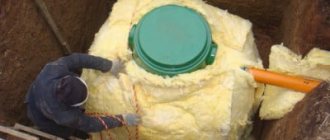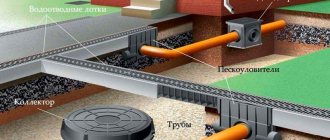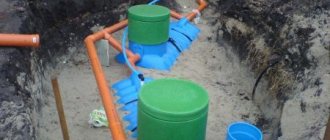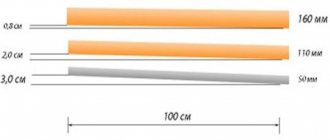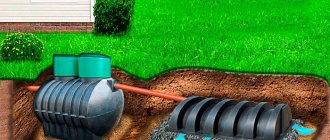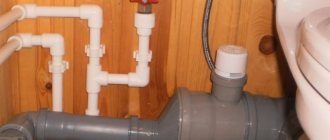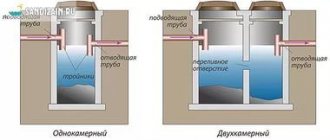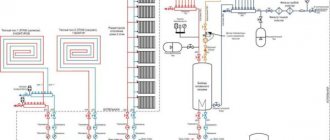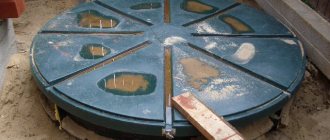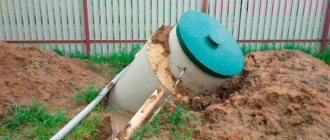Recommendation #1
Each station is designed for a certain number of people who will actively use water supply communications. To correctly calculate the volume of a treatment plant, it is recommended to take 200 liters per day per user. This standard is specified in SNiP 2.04.01-85. As an example: for 5 people, the volume of a septic tank for a 3-day stage of wastewater treatment is required to be three cubic meters.
Particular attention should be paid to the volume of simultaneous discharge of wastewater (the so-called “bulk discharge”). Since this indicator can greatly affect the quality of wastewater treatment. If the wastewater in the tank is allowed to exceed, this may even lead to system failure.
Features of use
The use of biological products must be carried out in strict accordance with the rules indicated on the packaging. There are certain requirements to ensure maximum effectiveness of the technique. These include:
- the volume of solid components should be 2 times less than the amount of water. If there is too much organic matter in the container, you need to add water to the desired consistency;
- idle time for more than 2 weeks is detrimental to microflora. If the break exceeds this period, you will have to add a new portion of bacteria to the container;
- If aggressive substances or antibiotics get into the tank, you will have to update the bacterial colony. To do this, add water to the container and place a fresh portion of the biological product.
In addition, you need to remember the temperature conditions. If the region experiences frosty winters, the septic tank must be properly insulated.
Recommendation #2
The main methods for removing water after it has been purified:
- for sandy and sandy loam soil, wastewater can be discharged into a filtration field or filtration well with a bottom made of crushed stone or gravel;
- for soil made of clay or with a high level of groundwater - drainage can be carried out into a reservoir or storm trench, but this method is available only to owners of factory septic tanks who carry out 95% cleaning. Otherwise, you may be subject to penalties;
- in the case when several households use one septic tank, the water flows into a special well, which acts as an intermediate stage between the treatment facility and the terrain. Purified water, which enters the well from a reinforced concrete ring and a sealed bottom, is pumped to the surface of the site by a drainage pump.
It is prohibited to drain water into a drainage ditch, as if there is an infection with helminth eggs, it can spread! But ready-made factory septic tanks cope well with this disease.
Recommendation #3
It is worth taking into account the freezing rate of the ground on the site during the cold season. This regulation is set out in SNiP 01/23/99. Everyone can independently calculate this value. For example, for Moscow and the region, the soil freezes to 1.40 meters.
For continuous use of the cleaning system or periodic use, but also in cold weather, you should place the pipe entry into the system below the freezing level, so you can prevent freezing of the drains in the system and damage to the pipeline system.
Performance of autonomous sewers
Sewage disposers must ensure trouble-free operation of the entire system. Before choosing a suitable model, you need to focus on the performance of the filtering equipment and the type of housing. Autonomous sewerage system for temporary (seasonal) residence. If you plan to live in a country house in the summer or only on weekends, it is best to use storage-type structures. Multi-chamber septic tanks will be an irrational option in this case. Single-chamber stations are perfect for seasonal homes. Compact mini-devices are easy to transport and install. There is no need to resort to the services of special equipment. Recyclers for year-round use. Objects intended for year-round use must be equipped with a biological treatment station or, in extreme cases, septic tanks with a ground treatment system. Modern models of utilizers consist of two, three or four chambers, as well as filtration fields called infiltrators. For the most effective cleaning, aerobic and anaerobic bacteria are used. Living microorganisms provide highly efficient processing of waste and organic matter. The biological treatment system allows the output to be a liquid suitable for technical needs, watering plants and other tasks. If the object is located in close proximity to a natural body of water, it is best to install a unit with deep cleaning. The liquid passing through such a station is not capable of causing harm to the environment. Which septic tank to install: rating of domestic models The Russian market offers a wide variety of treatment units for local sewerage. Today there is a rich variety of manufacturers who are engaged in the production and supply of recyclers. Many models are copies of leading European brands. However, some septic tanks are unique in their design and functionality and are fully suitable for Russian operating conditions. Russian consumers can find cleaning units on the market with different technical and operational characteristics. For a small country house you can purchase a miniseptic tank, and for a small country village an entire autonomous multi-stage filtration station.
Common septic tank models that have earned an impeccable reputation
- Topas. A recycler characterized by reliability and low energy consumption. A distinctive feature is the presence of 4 chambers and the presence of aerobic bacteria, which allows you to achieve a filtration rate of up to 97%.
- Eurobion. A unique model of the Yubas production association. The advantage of the unit is the presence of an innovative membrane system and a rhythmic aeration tank, which allows the device to be used even during long periods of downtime.
- Tver. A biological treatment station that performs filtration both biologically and mechanically. The device has a four-level system, which allows for highly efficient processing of sewage waste.
- Poplar. Septic tanks from. Reliable units are characterized by a high degree of filtration. Their distinctive feature is the presence of open access to the primary chamber, which greatly simplifies the removal of large fractions during maintenance.
- Triton. The company offers a wide variety of modifications that differ in their functionality. There are models of “Micro” and “Mini” class. Storage tanks come with the letter designation T and N.
- Tank. Reliable units from. Their features include high productivity from 600 to 1200 liters per day. Multi-stage processing of wastewater at the outlet allows you to obtain a clean liquid that is completely suitable for technical needs.
- Aster. Biological treatment station from Unilos. The presented models ensure the removal of harmful components up to 80%. Basically, the company offers septic tanks that perform their tasks well. Modern models can be supplemented with a multi-stage cleaning system. The water passed through the treatment equipment fully complies with sanitary requirements.
You may now be wondering which septic tank to choose for a private home from the list presented. All manufacturers offer products of decent quality. For example, it sells tanks for autonomous sewerage, which are characterized by increased durability. Polymer products have stiffening ribs and sufficient wall thickness, which allows them to withstand increased loads. They also do not float up even under the influence of floods. All presented factory models offer the ability to connect additional instruments and devices for the most effective filtration and control of equipment operation. Rostock septic tanks, which are produced, have also proven themselves well. A multi-stage filtration system using anaerobic bacteria allows the output to obtain the most purified liquid, suitable for any technical purpose. Septic tanks from are also popular. All models include a three-stage filtration system: mechanical, aerobic and biofiltration. When choosing, keep in mind that if the degree of filtration is only 60-75%, you will additionally need to install drainage tunnels to prevent groundwater contamination.
Recommendation #4
Its choice depends on how often the septic tank will be used. Ready-made solutions, such as “Bioxy”, “Unilos”, “Topas”, etc. ideal for regular use. Colonies of bacteria need constant feeding with human waste products. If this does not happen, they may hibernate.
You can restore proper operation of the system using kefir, animal feed or semolina. Thus, it is possible to revive the microflora of the treatment plant and put it back into operation. This advice makes it possible to use this kind of units for periodic use in the country.
Application area
The main purpose of biological products is considered to be the destruction of organic matter in autonomous sewage tanks. However, the possibilities of this cleaning technique seemed much wider. They are effective for preventing or removing excess deposits from pipelines. For example, bacteria for cleaning sewer pipes, which act in a similar way. The same microorganisms that are placed in the cavity of the system are used. An organic coating forms on the pipe walls, which is difficult to remove. Biological products cope with this task quite easily.
In addition, the technique turned out to be very effective for cleaning water bodies. Small ponds are not able to cope with the abundance of organic matter on their own and can turn into a swamp. The introduction of bacteria allows you to remove unnecessary components, making the water cleaner and more transparent.
Recommendation #5
Price is the deciding factor for the consumer. Astra and Topas stations have approximately the same price. The difference is the number of compressor equipment (“Topas” - 1, and “Astra” - 2), the number of models, regarding the connection with the supply pipe and the material from which the housing is made. The Bioksi brand, under generally equal conditions, is capable of treating a larger volume of wastewater, which is why the price is higher. A more expensive solution is units from Tver. Such septic tanks combine two complexes at once: a cleaning system and a chamber for the processing process. This option is great for a summer residence, but its cost is often high.
When deciding which biological treatment station is best to choose for your dacha, you should be familiar with the operating principles of the most popular systems.
Let's look at each station separately.
Which septic tank to choose, factory or homemade?
Homemade sewer systems are usually made of brick and concrete rings. With their help you can save a lot of money. However, their construction requires a lot of time and effort. Factory autonomous sewage systems are easy to install, reliable, and have a relatively low weight. Non-volatile septic tanks are equipped with infiltrators, which are a reservoir with gravel or crushed stone for additional cleaning. The advantages of factory equipment include the highest degree of filtration of wastewater. Factory models consist of several sections, which provides a multi-stage degree of cleaning. The liquid that has passed through the corresponding chambers can subsequently be used for technical needs. At the same time, when purchasing a ready-made model, you receive a guarantee from the manufacturer that the presented unit fully complies with construction and environmental regulations.
"Topas"
Topol-Eco NEVA is a manufacturing company that holds the palm in Russia regarding the development and production of cleaning systems of the Topas series. They were the first to bring a unique product to the market in 2001.
The principle of operation of the Topas septic tank is a symbiosis of two cleanings: biopurification and oxidation of human waste products. Aerobic bacteria actively decompose organic matter into its constituent parts. This process occurs with the help of a constant flow of oxygen.
Topas 8 station
The lineup:
- for different numbers of users there are for 4 or more people who permanently reside in the house;
- depending on the placement of the pipe, for transporting wastewater from the home to the unit;
- with different amounts of compressor equipment (look at the name, it must contain “C”);
- presence/absence of a drainage pump (the name must have “Pr”).
Such systems are suitable not only for dachas, but also for small settlements and cottage towns, with a population of 50 to 150 people. The company's managers will help you select the necessary cleaning station, based on the individual characteristics of the area and other mandatory conditions for optimal preservation of the ecological cleanliness of the area.
Positive aspects of the work of the Topas WWTP:
- a wide range of models, which is designed not only for different numbers of residents, but also for the characteristics of groundwater;
- ground resistance due to durable base material;
- ease of operation and cleaning;
- silent operation;
- purified water can be supplied directly to a pond or drainage ditch, since a high degree of purification (95%) is guaranteed by the manufacturer.
Negative points:
- the station requires constant use of electricity, consumption rates may vary depending on the model;
- special requirements for the composition of wastewater (for example, the absence of chlorine, as this can kill working bacteria);
- high cost compared to competitors' prices.
| Model | Number of users | Dimensions (LxWxH), mm | Electrical energy consumption | Productivity, l/day | Link to reviews |
| 4 | 4 | 950x970x2500 | 1.5 kW*day | 800 | Go to reviews |
| 5 | 5 | 1150x1170x2500 | 1.5 kW*day | 1000 | Go to reviews |
| 6 | 6 | 1150x1170x2550 | 1.5 kW*day | 1150 | Go to reviews |
| 8 | 8 | 1630x1170x2500 | 1.5 kW*day | 1500 | Go to reviews |
| 9 | 9 | 1630x1170x2550 | 1.5 kW*day | 1700 | Go to reviews |
Local treatment plants: about the principle of operation
All local treatment plants operate on the same principle: First, the compressor supplies a large number of small air bubbles into the working chambers of the aeration elements for biological oxidation.
Then the wastewater is pumped by a compressor, depending on the type of structure, into an aeration tank or into a biofilter. In the latter, the final destruction of organic compounds is realized.
The mixture of clean water and sludge in the aeration tank goes to the secondary settling tank, where it is divided into water and sludge thanks to the work of aerobic bacteria. Sewage masses, due to biological destruction under the influence of air, eventually turn into water. The difference between a biofilter and an aeration tank is that anaerobic bacteria, unlike aerobic bacteria, exist in the environment without oxygen. Structurally, septic tanks with a biofilter do not require aerators to supply air to the station.
As a result, purified water is removed by gravity or forcibly, and only sludge remains in the stabilizer.
Septic tank "Tank"
The Tank cleaning system is more economical compared to Topas, but only if your area has a normal water level. Otherwise, the costs will be equal, since it is necessary to install additional elements for the proper operation of the structure.
Positive points:
- there is no dependence on electricity, since the system operates autonomously without being tied to a resource;
- the design is resistant to soil influence, but it is necessary to follow all the rules and processes during installation in the soil;
- economical cost;
- vfewer models compared to Toppas, but this point is mitigated by the fact that there is a moment of increasing the modular composition of the system to service large volumes of wastewater.
Station "Tank"
Negative sides:
- under the influence of groundwater, the structure may float up, but only if the installation technology is violated;
- The quality of wastewater treatment suffers (only 75%), so the system needs additions in the form of an infiltrator and a pump that will carry out drainage work. This will be necessary when the groundwater level is high.
| Model | Number of users | Dimensions (LxWxH), mm | Volume, l | Productivity, l/day | Link to reviews |
| 1 | 1-3 | 1200x1000x1700 | 1200 | 600 | Go to reviews |
| 2 | 3-4 | 1800x1200x1700 | 2000 | 800 | Go to reviews |
| 2.5 | 4-5 | 2030x1200x1850 | 2500 | 1000 | Go to reviews |
| 3 | 5-6 | 2200x1200x2000 | 3000 | 1200 | Go to reviews |
| 4 | 7-9 | 3600x1000x1700 | 3600 | 1800 | Go to reviews |
Main features of deep cleaning septic tanks:
- possibility of installation on any soil - the body is made of reinforced plastic that can withstand pressure and movement of heavy (rocky, clayey) soils;
- high degree of purification - 98%, purified water can be used for watering garden crops and even discharged into natural reservoirs;
- absolute absence of odor - microorganisms processing the material do not emit ammonia.
It should also be noted that there is no need to call a sewer truck - activated sludge is formed in the chamber, which is removed once or twice a year (the resulting sludge can be used as fertilizer).
Septic tanks "TOPAS": advantages and disadvantages
"TOPAS" is one of the best septic tanks, the service life of which exceeds 50 years. The station has the shape of a parallelepiped. It is created from separate sheets of plastic soldered together.
Advantages and distinctive features of TOPAS:
- Diverse selection of models.
- Advantageous package.
- Easy to install.
- Tightness.
- Availability of drain level sensor.
"TOPAS" is complemented by two compressors operating alternately. Each of them is connected separately. If one compressor fails, the equipment will not operate efficiently. This is a big disadvantage. The manufacturer recommends replacing compressors once every 10 years.
The disadvantage of TOPAS lies in the shape of the body. There is a lot of ground pressure at its corners. Therefore, installation should be entrusted to specialists who will help arrange the foundation pit correctly from a technical point of view.
Buy a septic tank for your dacha “Dochista Profi”
The Dochista Pro septic tank is an alternative to centralized sewerage. The local treatment station “Dochista Pro” is the best option for a septic tank for a home with permanent residence. Used as a universal autonomous sewer system for private households, cottages, and summer houses. Provides effective filtration and biological processing of domestic wastewater with a high degree of purification (at least 98%). The device can also be installed in places where soil water has a high ground level. We offer different options for Dochista stations, differing in performance, design, dimensions, and cost. When using a branded service for the delivery and installation of a turnkey septic tank, the price of the services is most favorable due to current promotions, and the device is guaranteed to work for a long time and without interruptions.

